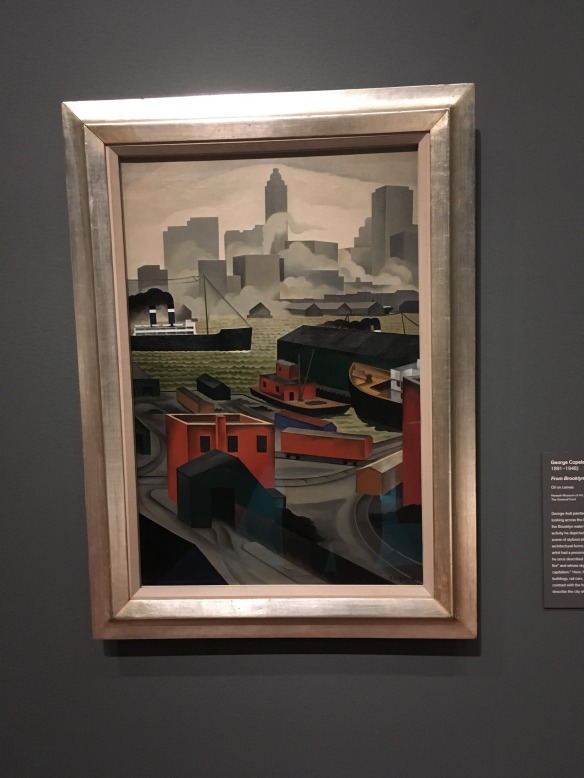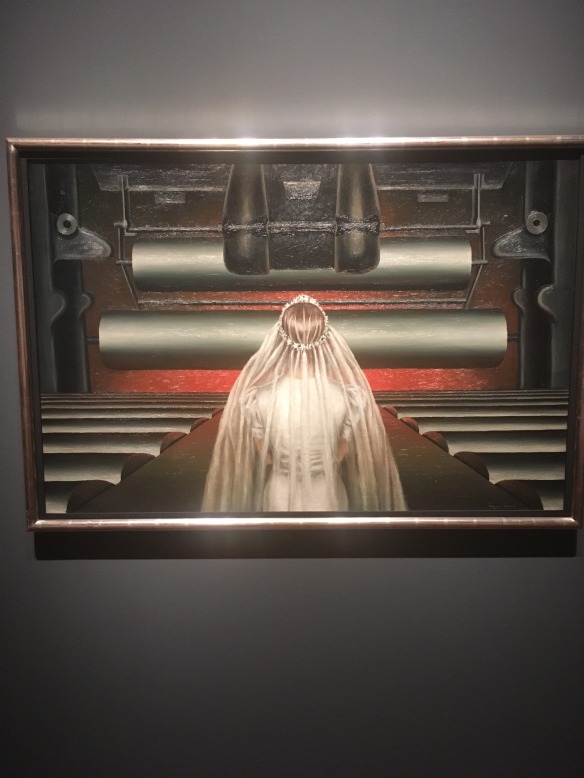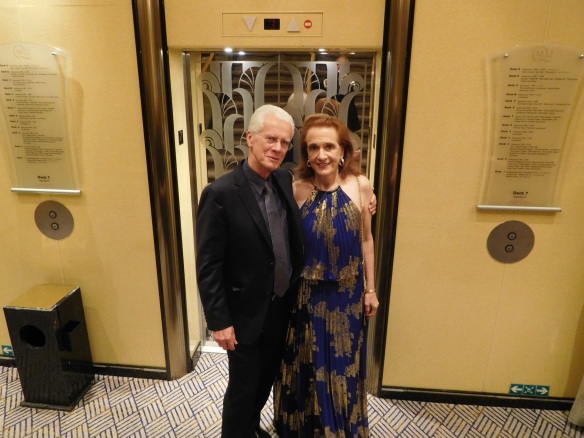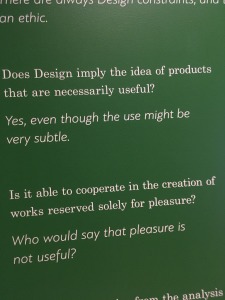Varda’s passing has been well noted already and I just want to add that her Les Glaneurs, The Gleaners and I, is one of my all-time favorite films. The gathering of left-overs and the parallels with creative endeavor, with bricolage in general and editing as well, resonates through that film beautifully, as do her reflections on mortality. She uses a hand-held digital camera to return to the era of oil painting and original work of art with its unique aura, a very clever way of undermining the magic and miracles wrought by technology which she clearly appreciates but insists on placing in a larger perspective. Varda was an original and she is missed.
Anniversaries
Everyone has a birthday every year but we save anniversaries for yet more special occasions, from long-term survival in marriages and jobs, to the continued existence of vital institutions, documents and countries.
And even Film Departments.
In this case, the Film Department, now, of course, the Film and Media Department, at Queen’s University in Kingston, Ontario.
Founded in the late ’60s by the noted Canadian scholar Peter Harcourt, it was quickly off and running, hosting distinguished faculty, turning out grads who went on to considerable success, and becoming a fixture in the staid landscape of a venerable but quite traditional university.
Now fifty years later, it’s time for an anniversary and I have a chance to attend and make a small contribution. I haven’t been back but once since spending the first thirteen years of my career there and I am looking forward to offering a report on what the intervening time has wrought.
It seems, at the very least, that the Department has managed to age gracefully and to mature into a major player on the national stage.
Wayne Thiebaud: Master of Cupcakes and More
Both SFMOMA, with an expansive show of work curated by Thiebaud and of his own work, and the Oakland Museum of Art, with a single painting among their excellent collection of work by California artists, remind us that Thiebaud did more than paint desserts. [The next post is on Ray and Charles Eames and their work, also written today.]
He also did portraits and landscapes.
The landscapes remind of Diebenkorn, another Bay Area artist who focused on flat depictions of landscape and sometimes people. Neither artist had much use of Renaissance perspective; they preferred to stress the flat surface on which the work appeared as the sum total of its depth, even if hints of a greater depth also appeared. Reminiscent of some of Magritte’s work, where, for example a painting of the cone-shaped turret of a tower mirrors the receding image of a road, except it is on an easel within the painting and the road is “really” outside the artist’s studio in the world. (I can’t recall the title so send a note if you know it!)
At SFMOMA this work is in the show:
At the OAM this work appears:
Both works feature black strips of road that seem to rise from top to bottom without receding into the distance, like Magritte’s tower. The same effect plays out with walls and rooftops. Thiebaud, like Diebenkorn, reminds us the true (flat) nature of the painting even as he also teases with hints of a representation of a recognizable landscape. Now you see it (a patchwork of color assigned to a canvas) and now you don’t (an illusory piece of world pasted on a canvas sheet).
These works are just a good reminder of how artists play with the medium and the form to give us the many pleasures we enjoy.
Ray and Charles Eames in Oakland
A Sunday afternoon at the Oakland Museum of Art isn’t quite like going to one of the big tourist destination museums in the Bay Area but it should be.
There is a current exhibition devoted to Ray and Charles Eames, the couple who invented Chairs,designed houses, invented splints and stretchers (in WWII), and made films. They have never left the never left the design landscape given how massive their influence has been.
The object on the left, of shaped plywood, was manufactured in the 1000s for the military during WWII. the object on the right is a spin off, a free form figure by Charles based on the splint.
In a Q&A posted on walls of the exhibit, Eames gives one sentence answers to a series of essay questions. Some take up the question of the splint:
The Eameses, designers by their own admission, remind us that they, like Picasso or Rembrandt, are useful and purposeful but in a more subtle way than an industrial, use-value oriented culture might appreciate. Art and great design affords pleasure. Pleasure is not only useful but essential. It is one of the two great “principles” described by Freud but we don’t need Sigmund to tell us what life without pleasure would be like. That is a purpose fulfilled by great design and great art alike. Design may also solve industrial problems, problems of commodity production and consumption, but at best, as here, it does more than that.
Consider the Eames chair:

 A pricey item today, and a true classic, but also–is it not?–a source of pleasure. It fulfills the need for pleasure by the grace and beauty of its design even as it supports the human body in a seated position. (I confess: I have one. But only one.)
A pricey item today, and a true classic, but also–is it not?–a source of pleasure. It fulfills the need for pleasure by the grace and beauty of its design even as it supports the human body in a seated position. (I confess: I have one. But only one.)
The exhibit includes several of the Eames’s films as well, including the famous Powers of Ten and Think. They built their films as ensembles, bits and pieces hanging together by the thread of an idea and the form retains its power and beauty to this day.
The exhibit is on for a few more months.
Factory Fetishism
The de Young museum has its Cult of the Machine show on. Machines: futurists loved them; Constructivists praised them; Precisionists fetishized them, or, at least, some of them did. Charles Scheeler, Charles Demuth sure did love ’em. The show gives them their due and they deserve it. Scheeler, in particular, reveres the majesty and mystery of machines, industry, power as an alchemist’s brew of transformation. It even transforms humans right out of the picture. His and most of these guys pictures are of industrial might, not as menacing but majestic, sublime, beyond our capacity to fully appreciated even if we created it.
But the show has an underbelly. They’re the works that fascinated me for having some sense, as some do now, of what lurks beneath the utopian dreams, the ones heard now of a world of communication, connection and Friends(hips).
They saw things a little differently.

Void of humans but abristle with energy and motion, there is an ambiguity at work. Seen from on high, the New York city waterfront runs like a ribbon through a tissue of industry, but one that sends up signals of smoke and steam whose meaning is unclear. Perhaps the ambiguity is what convinced Georgia O’Keefe to move to New Mexico.
And then there’s this:

In this work by George Ault, factory and ship smoke, white and black, obliterates whatever lies beyond it. And the far shore is entirely grey with waterfront wharves and buildings that seem to emerge from or plunge into the water. Up close it is as if the water swallows the buildings; man has not fully emerged from his watery beginnings.

Here, O’Keefe captures two great, black monoliths and a white one beyond, all dwarfing the silvery moon that sneaks out between them all. Boldly bleak, capturing the canyon like enormity of New York, it also lacks warmth or comfort, a far cry from the desert world of flowers she later turned to.

Ault didn’t see the rural American of the ’30 as much better. Black, devoid of any enlivening detail, absent humans, a warped and pointless fence, the shapes and geometry that give the city its dynamism appear here more as a sepluchral loss than a rustic retreat.

With a little hint of mischief the show also includes this shot of Imogene Cunningham and the model Twinkie where Cunningham appears as if she might be coming upon Susanna before the elders find her. Her camera seems to be the main link to the other works and the humor of the shot is largely absent elsewhere, save for the inevitable clip of Charlie Chaplin caught in the gears and cogs of an assembly line from Modern Times.
And for a finale,

Charles Holbrook Carter’s War Bride, faceless and alone before the altar, or machinery (of the church?), with pews that look like aircraft hangars and two gear works on either side that could be totems from another era. Who gets to marry the machine? Who is left behind? Can anyone survive the marriage of heaven and hell, or man and machine–questions we seem to ask in one form or another every day.
Sublime Seas
Across the Atlantic
Long ago in a far away place, my mom took my sister and me to see Aunt Marie off to lead a guided tour in Europe. She sailed on the Queen Mary. She gave me a sip of champagne. I became light-headed. Ever since I have wanted to make a transatlantic crossing on the Queen Mary (now 2).
I just did it. On a New York Times package that included several talks per day.
So we wandered New York one night, visited a drab and weakly guarded Trump Tower, saw Jeff Koons up to his usual materialist shenanigans (pimping at Saks):

Koons does a van Gogh imitation and festoons Vuitton handbags with his “artistry”
Toured the NYT building and then beheld the ship.

Bigger than a Skyscraper it is
Somehow an upgrade befell us.

So the cabin and the sea were large and calming.

Thank the Queen for Upgrades

Alert for pirates and buccaneers
Dinners and after-dinner entertainment were formal several nights, after all it is the Queen’s ship.

And then life went on. On to Salisbury and Stonehenge

What compelled their maker to heave this massive stones together over decades if not centuries?
Salisbury Cathedral had some stunning art by Ana Marie Pecheco

Lust: about 12″ x 15″ each sin had its own illustration

Full size wood carvings: The Wanderers. Pacheco’s work was very impressive
Then Oxford, a town aswarm with tourists, mostly youthful, perhaps future graduates of this ancient site.
Of course, I thought, we have to hear a lecture by a Professor on an arcane, esoteric topic that could only happen at Oxford, or maybe Berkeley. Luckily the Ashmolean was celebrated something and there was a lecture of Riddles in Early Anglo Saxon literature.
The room was packed and the professor, Andrew Orchard, whipped from Greek to Latin to old English as if it were all simple nursery rhymes, reciting poems and dashing off explanations of what they did to make their riddle work. A perfect Oxford moment.
And then London.
MacBeth was in the courtyard of St. Paul’s at Covent Garden and the production was superb. Visceral and imaginative with fine acting.

Banquo returns from the grace to haunt the already guilt ridden MacBeth.
And to keep up to date, a visit to the West End to see “the play of the year,” The Ferryman. a fabulous exploration of guild, betrayal, family, desire, loyality and memory in the Ireland on 1980. It built to a climax of massive proportion just like the classic Greek tragedies.

There was also the Tate Modern but I could not take photos of the Giacometti exhibit of the powerful and comprehensive survey of African-American art in the 1960s and 70s that resonated with the issues of civil rights and black power. It originated here but I can’t imagine it won’t find its way to the States.
Forget the Past
A Short Comment about our Leader
Our Congressional Democrats see the daily blunders, endless lies and massive policy disasters of the President but not what explains them.
He, and others like him, have returned to a medieval system of belief. He lives in the time warp where beliefs prevail by the sheer force of will exercised by potentates and their minions.
The medieval mind knew nothing of scientific evidence. Science, reason and the Enlightenment had not yet arrived.The Dark Ages depended on blind faith, unquestioned fealty, and willful ignorance. Rulers, in their privileged isolation, lived in an idyllic world of riches and prosperity in which poverty, pollution, despair and desperation did not exist or was the natural fate of those who deserved such misery through faults entirely their own.
To recognize that dignity and respect for others matter, that good healthcare should be a right, that a financially secure retirement should be assured, that the working class isn’t the only or even main place to find deplorable actions and thoughts—all this matters greatly. But without a firm grasp on Trump’s medieval worldview, it appears as mere disagreement about ways and means rather than a rejection of a world cut to the measure of a small elite who disregard proven truths and established facts. Normally the province of religious extremes of all faiths, Trump proves that it can also be the default position of the insecure, uninformed, belligerent and defensive ones for whom curiosity and compassion no longer exist.
When will the Democratic Party wake up?
This is an open letter to the DNC (Democratic National Committee) about their failure to confront Trump effectively. I haven’t sent it yet and welcome feedback.
Dear Democratic National Committee and Surrogates:
They say any publicity is good publicity and by that standard the DNC is doing a world of good for Donald Trump. Every fund request I get tells of another blunder or outrage, acts that do little to upset his base.
What I don’t hear is what the Democratic Party offers as an alternative. That means zero publicity for what really matters: a radically different vision for an America we can once again recognize as our own.
You lost the election, on multiple levels. Put your house in order and invite us in.
Address, at the very least:
Will you revitalize and pursue the Democratic platform devised at last year’s convention and use it as a building block to the future?
What will you do to return us to a Post-Enlightenment (17th century on) world that understands how science freed us from myth, superstition and folly? The Republicans have opted for a medieval system of belief that denies scientific evidence in favor of blind faith and willful ignorance. How will you make clear the difference, especially among those susceptible to a system the nurtures unverified claims and demagogic appeals?
When will you stop pretending the working class does not exist, or is populated with undesirables? Factory workers are not members of the middle class as President Obama seemed to believe. They earn wages not salaries and have much less security, just for a start. Saving the middle class, the sub-title of Elizabeth Warren’s new book, ignores those whose future stands in yet starker jeopardy. When will you speak to and for a core constituency you have overlooked and sometimes disdained?
How will you stop corporations and rich individuals for shirking their responsibility to pay taxes? We may have a high corporate tax rate but it is a fiction, obviously so when companies like Apple can shelter vast amounts of profit in foreign nations, untaxed.
When can Medicare be gradually extended downward to become a universal health care system? How will you handle the vested, private interests that turn health into a profit center?
How can we acknowledge the difficult status quo of semi-legal and illegal immigrants and offer a path to citizenship as well as a well-coordinated plan to limit illegal entry in the future?
What tangible steps and new legislation will secure equal rights for all genders and sexual orientations as well as all ethnic and religious groups?
How will you acknowledge the fear, resentment and even hatred expressed by some whites who can no longer take their historical racial or gender privileges for granted? How can the sense of an all-inclusive American People can be restored?
What concrete steps do you propose to counter terrorism by building democratic institutions, especially in countries that lack democratic traditions? What texts should be read in schools, what role can local and regional governments play, how can citizens make their voices heard and respected, when can tribal leaders and warlords have their power reduced? Isn’t it time to step back from endorsing monarchs, oligarchs, patriarchs and illiberal ultra-nationalists who refuse to find a way to accommodate and respect minority groups of all kinds? We say we want to bring democracy to others but more other bring little more than death and destruction. What will you do to change this?
Why do I not hear about action, real action, in these directions?
I can vote against someone, but I also want to ACT FOR something.
This are hard questions but without answers the Democratic Party will remain a party of the past.
Scenes from Budapest
i’m back in Budapest, teaching in the DocNomad program, a grad program where students spend the year going from Lisbon to Budapest to Brussels making docs along the way. It’s a great program. And here are some impressions from the city where Orban’s rubber stampers just voted to close the Central European University, a great university too liberal, it seems, for Orban and his far right policies.

A mural inspired by Chagall outside a cafe named after him. There is still the charm to hide the lessons in darkness














